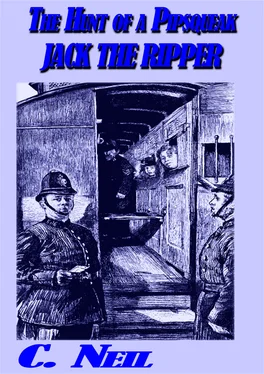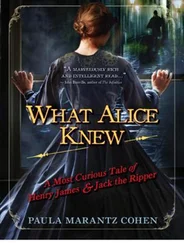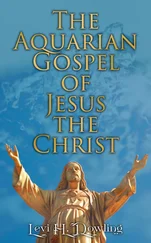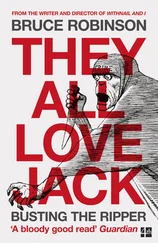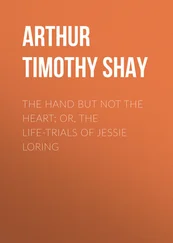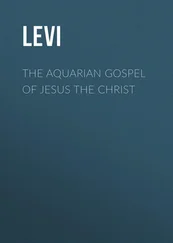C. Neil - The Hunt of a pipsqueak Jack the Ripper
Здесь есть возможность читать онлайн «C. Neil - The Hunt of a pipsqueak Jack the Ripper» — ознакомительный отрывок электронной книги совершенно бесплатно, а после прочтения отрывка купить полную версию. В некоторых случаях можно слушать аудио, скачать через торрент в формате fb2 и присутствует краткое содержание. Жанр: unrecognised, на немецком языке. Описание произведения, (предисловие) а так же отзывы посетителей доступны на портале библиотеки ЛибКат.
- Название:The Hunt of a pipsqueak Jack the Ripper
- Автор:
- Жанр:
- Год:неизвестен
- ISBN:нет данных
- Рейтинг книги:4 / 5. Голосов: 1
-
Избранное:Добавить в избранное
- Отзывы:
-
Ваша оценка:
- 80
- 1
- 2
- 3
- 4
- 5
The Hunt of a pipsqueak Jack the Ripper: краткое содержание, описание и аннотация
Предлагаем к чтению аннотацию, описание, краткое содержание или предисловие (зависит от того, что написал сам автор книги «The Hunt of a pipsqueak Jack the Ripper»). Если вы не нашли необходимую информацию о книге — напишите в комментариях, мы постараемся отыскать её.
The Hunt of a pipsqueak Jack the Ripper — читать онлайн ознакомительный отрывок
Ниже представлен текст книги, разбитый по страницам. Система сохранения места последней прочитанной страницы, позволяет с удобством читать онлайн бесплатно книгу «The Hunt of a pipsqueak Jack the Ripper», без необходимости каждый раз заново искать на чём Вы остановились. Поставьте закладку, и сможете в любой момент перейти на страницу, на которой закончили чтение.
Интервал:
Закладка:
Yesterday an inquestwas held at the Horse Shoe and Magpie, Saffron Hill, before THOMAS STIRLING, Esq., Coroner, on the body of James Parkinson, aged 36, who came by his death under the following circumstances. The Jury proceeded to view the body of the deceased, which lay in the upper part of a low lodging-house for travelers, in West Street, Saffron Hill. It was in a high state of decomposition, and a report was generally circulated that he had come by his death by unfair means. Mary Wood being sworn, deposed that she was the landlady of the house in West Street, which she let out in lodgings. The deceased occasionally lodged with her, and he was a dealer in cat’s meat. On Tuesday night last he came home and asked her for a light, and proceeded to his bedroom. On the Wednesday witness proceeded upstairs to make the beds, when she saw the deceased lying on his bed apparently asleep, but she did not speak to him. On the Thursday she proceeded to the upper part of the house for the same purpose, when she again saw the deceased lying as if asleep, but she did not disturb him, and he was ultimately discovered to be a corpse, and his face quite black. Juror. Pray, how many beds are there in the room where the deceased slept? Witness. Only eight, and please you, Sir. Indeed, and how many persons are in the habit of sleeping in the same apartment? —There are generally two or three in a bed, but the deceased had a bed to himself. Very comfortable truly. Is it not strange that none of his fellow lodgers ascertained that he was dead? —No, Sir, they go in and out without seeming to care for each other. Do you mean to say, if a poor man was to take a lodging at your house, you would let him lie for upwards of 48 hours without inquiring whether he required nourishment? —Why, Sir, I have known some of my lodgers, who have been out upon the spree to lay in bed for three and four days together, without a bit or a sup, and then they have gone out to their work as well and as hearty as ever they was in their lives; I have known it often to have been done. There was plenty of grub in the house if he liked to have asked for it; but I thought if I asked him to have victuals he would be offended, as he might receive it as a hint for the few nights’ lodging that he owed me. Mr. Appleby, the parish surgeon, proved that the deceased died a natural death, and the Jury returned a verdict of ‘Died by the visitation of God’
The Morning Herald, Feb.11, 1834
BABY FARMING.-An inquest was opened on Tuesday at the schoolroom adjoining St. John's Church, Milton, on the bodies of two children, found in the house occupied by Esther Williams and Emily Green, on Wednesday last, information of his suspicions as to foul play having been given by Dr. Waring. The mother of one of the infants, Mary Kempton, identified the male child as hers, and said she left him in charge of Green in November last. The child was then well and healthy. It was now in a most emaciated condition. - Dr. Waring, parish doctor, said he was called to attend this child on the 3d of January. It was then suffering from a mild form of bronchitis. He afterwards noticed that it wasted away alarmingly, and spoke to Green about it. She said that it would not take its food, and he prescribed a mild stimulant. His opinion of both the deceased children was that they were starved to death. They had been fearfully neglected, as were also the other children found in the house, none of which were the offspring of the prisoners. - Chief-Inspector Moloy said he had not been able to discover the parents of the other children up to the present, but no doubt the publication of the case would bring them forward. One of the children that had been removed to the infirmary was in a dangerous state. - Charles Gordon, living next door, said the cries of the children were heartrending at times. They had only been in Milton about three months. - Mr. James Williamson, the deputy-coroner, said the facts disclosed a shocking state of things, and he thought it would be well that an adjournment should take place for a week, in order to give time for the parents of the children to come forward. - The foreman said the jury were agreed to at once bring in a verdict of "Willful murder" against Green, but the coroner said he should adjourn the case for a few days.
Martha Tabram a.k.a. Emma Turner
Born: Martha White, May 10, 1849, at 17 Marshall Street, London Rd., Southwark Father: Charles Samuel White, a warehouseman Mother: Elisabeth (Dowsett) Brothers: Henry (twelve years older than Martha), Stephen (8 years older) Sisters: Esther (10 years older), Mary Ann (3 years older) Martha's parents separated and in May of 1865 Charles was lodging alone in the house of Mrs. Rebecca Glover. The house was located at 31 Pitt Street, St. George's Row. His health was questionable, he suffered severe diarrhea in October and a surgeon was called to examine him. The surgeon found him troubled by his familiar situation and complaining of bad circulation and cold. According to his daughter Mary Ann, he also stated that he had a weak back and was unable to work. On October 11th his estranged wife, Elisabeth, visited him for the first time since their separation. Over the next few days she visited often and on the evening of November 15th, both she and her daughter Mary Ann had supper at his lodging. The meal consisted of bread, butter, and beer. According to his landlady, Mrs. Grover, he was cheerful that evening. At approximately 10:00 PM, he rose to go to bed and while removing his waistcoat he fell to the floor and died. As there was no evidence of any thing suspicious, the death was ruled as coming from natural causes. He was 59 years old. On Christmas Day, 1869, Martha married Henry Samuel Tabram at Trinity Church in St. Mary's Parish, Newington. He was a foreman furniture packer. A short, well dressed man with iron gray hair, mustache and imperial. They had already been living together in Pleasant Place and moved to 20 Marshall Street in February 1871. The new house was very near by the house in which Martha was born. Martha had two sons by the marriage, Frederick John, born in February 1871 and Charles Henry, born in December of 1872. The marriage ended in 1875. Henry left due to Martha's heavy drinking. He gave her an allowance of twelve shillings per week for three years but reduced it to 2s 6d due to her pestering him in the streets for money. She had a warrant taken out against him and had him locked up. He had also learned that she was living with another man. At this time he refused to support her any further. Henry Turner was a carpenter with whom Martha lived, off and on, for twelve years. He is described as a short, dirty man who dressed in a slovenly manner. He was young and had a pale face, light moustache and imperial. Their relationship also appears to have been greatly effected by Martha's drinking. Turner stated at the inquest into her death: "Since she has been living with me, her character for sobriety was not good. If I give her money she generally spent it in drink." Martha was in the habit of staying out late at night, usually not returning before 11:00 PM and occasionally staying out all night. Her excuse was usually that she had been taken with hysterical fits and had been taken to the police station. Turner had witnessed these fits and stated that they usually came about due to drunkenness. In 1888 Turner was out of regular employment and making his living hawking cheap trinkets, menthol cones and needles and pins. The couple lodged in the house of Mrs. Mary Bousfield at 4 Star Place, Commercial Road. Bousfield described Martha as a person who would "rather have a glass of ale than a cup of tea." She also said, however, that she was not a perpetual drunk. The couple left their lodgings without notice and behind in the rent approximately 4 to 6 weeks prior to the murder. Perhaps out of guilt, Martha secretly returned one night and left the key to the lodging without seeing the landlady. Turner left Martha for the last time in July of 1888. At the time of her death he was living at the Victoria working man's home on Commercial Street. She tried to carry on earning a living through selling trinkets and prostitution. It is very likely that whatever small amount of money she made was spent on drink. Indeed, Turner is quoted as saying "If I gave her money she generally spent it on drink. In fact it was always drink. When she took to drink, however, I usually left her to her own resources, and I can't answer to her conduct then." Her last known address was 19 George Street, Spitalfields (known as Satchel’s Lodging House). Turner saw a destitute Martha for the last time on Leadenhall Street, near Aldgate pump on August 4, 1888. He gave her 1s 6d to buy trinkets for trade with which she might earn some sort of living. On Bank Holiday Monday, August 6th, Martha went out with Mary Ann Connelly, who was known as "Pearly Poll." They were seen throughout the evening in pubs in the company of a soldier or soldiers. According to Pearly Poll, she and Martha picked up two guardsmen, a Corporal and a Private in the Two Brewers public house and drank with them in several pubs including the White Swan on Whitechapel High Street.
Читать дальшеИнтервал:
Закладка:
Похожие книги на «The Hunt of a pipsqueak Jack the Ripper»
Представляем Вашему вниманию похожие книги на «The Hunt of a pipsqueak Jack the Ripper» списком для выбора. Мы отобрали схожую по названию и смыслу литературу в надежде предоставить читателям больше вариантов отыскать новые, интересные, ещё непрочитанные произведения.
Обсуждение, отзывы о книге «The Hunt of a pipsqueak Jack the Ripper» и просто собственные мнения читателей. Оставьте ваши комментарии, напишите, что Вы думаете о произведении, его смысле или главных героях. Укажите что конкретно понравилось, а что нет, и почему Вы так считаете.
